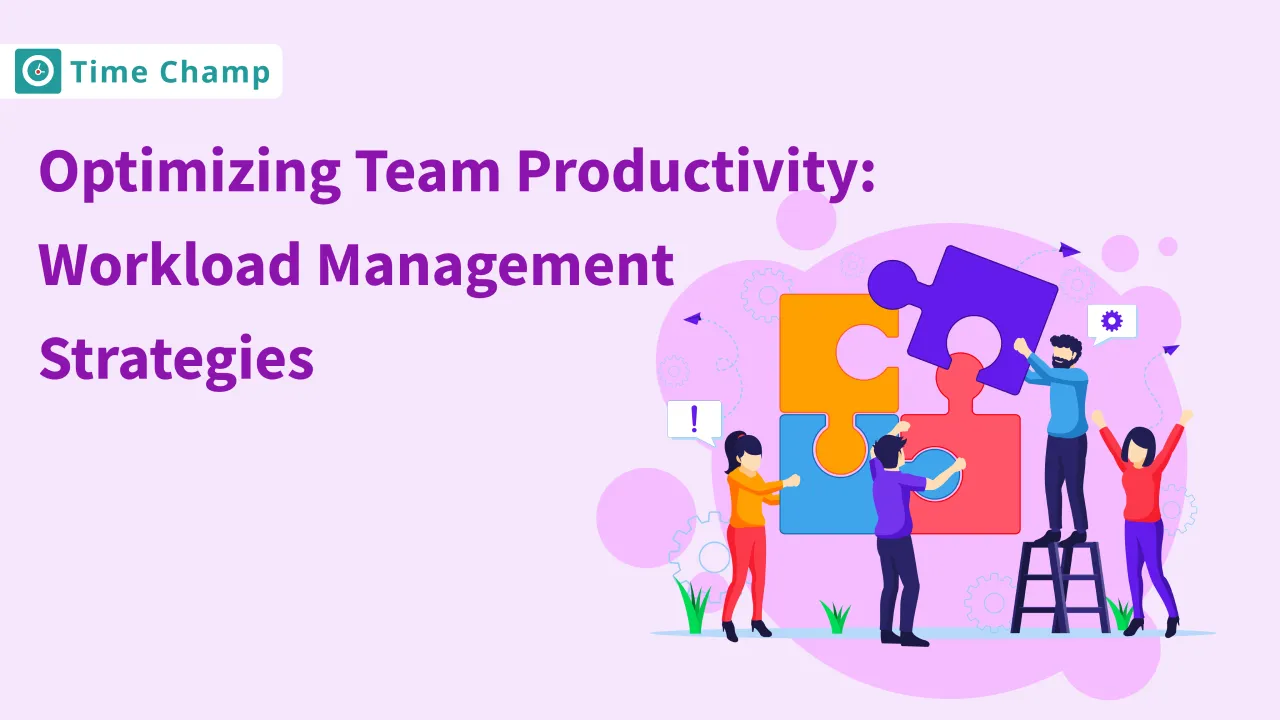Today, in this fast-changing business world, effective management of a team’s workload is an essential component in helping you accomplish organizational objectives and remain competitive. It’s a delicate balance between tasks, resources, and employee well-being. The key is an appropriate workload management plan to help navigate these choppy waters. Workload management, monitoring, and tracking workloads and progress can increase productivity, create a better working environment, and determine the success of an organization.In dealing with employee workload management, managers must first have the tools and methods. In this regard, solutions like TimeChamp can help both leaders and staff to collaborate in a much smoother workload management process.
In this extensive blog, we’ll look at several aspects of workload management, from strategic planning to involving a good team. Also, we will explore what the best techniques are that teams can use to better manage their workload and boost productivity. When it comes to strategies in depth, however, don’t forget that we have everything you need to schedule your team eventually and put them to effective use.
1. The Value of a Workload Management Plan:
Just as on a journey, when everyone has a map to follow throughout the maze of tasks and priorities, every member understands what their role is in the organization. A carefully considered plan allows for the quantity of work, the pressures of a deadline, and their impact on individual capabilities. It is an environment where resources are optimized and burnout is minimized.
Understanding Workload Distribution
Understanding that task distribution across the team is key to maintaining a reasonable workload. By evaluating the abilities of each individual on the team, managers gain a better idea about how to split up work to prevent anyone from being overburdened or underutilized. This allocation of tasks also helps in achieving project deadlines, but at the same time ensures that firm employees get to work on projects consistent with their skills and career orientation.
Setting Clear Objectives and Priorities
A clear definition of objectives and priorities is another pillar of an effective workload management plan. It means defining the important work, setting actionable objectives, and planning tasks according to degree of urgency and importance. In this way, teams can concentrate on those things that matter without falling into the traps of low-value activity.
2. Workload Management Strategies:
The key to a great workload management strategy is a mixture of looking to the future, being able to adapt, and seeing how you can do better next time. These strategies should change with the changing objectives of the organization and workforce.
Aligning Workloads with Business Goals
Workload management strategies must bear close relations with overall business plans. In other words, it is to make sure that the work done by a team contributes toward the long-term goals of the organization. This alignment provides a sense of direction and ensures that employees direct their efforts where they are most needed.
Flexibility and Adaptability
Workload Management’s ability to adapt to change is of crucial importance. When project plans change or new obstacles suddenly emerge, strategies must be flexible enough to allow for changes without provoking disturbances. Workload distribution and priorities are reassessed regularly, and adjustments are made if necessary to keep the team in the same direction.
3. Workload Planning and Tracking:
Note, however, that effective workload management is not cast in concrete; it needs continuing planning and monitoring to keep the ball rolling and try to avoid bottlenecks before they become major problems.
Utilizing Workload Tracking Tools
The digital era has created many tools to ease workload monitoring, and Time Champ is a fine example. By using these tools, managers get real-time views of the team’s performance and workloads. This allows them to keep track of progress, distribute tasks fairly, and manage resources more effectively.
The tools provide capabilities including effective task and project management, time tracking, workload heatmaps, and custom reports, which can be a gold mine of information for further fine-tuning workload management processes. Workforce management systems like TimeChamp offer real-time monitoring, and managers can avoid overwork and underperformance by detecting shifts in employee work patterns.
Consistent workload reviews play an important role.
Periodically reviewing the workload reveals trends and patterns which may be indicative of inefficiencies. Suggestion, weekly or bi-weekly meetings for discussing workload distribution, deadlines, and obstacles. Such reviews promote open discussion within the team and give employees a vehicle to express their worries, complaints, or proposals for changing workloads.
4. Workload Management within Teams:
Workload management is not the exclusive responsibility of managers, it must be a shared effort by everyone on the team. Working together on managing the workload strengthens bonds of team spirit so that everyone is concerned with how well the group works and succeeds.
Fostering Team Collaboration
When a group of team members can exchange ideas and share burdens openly, the unit remains intact. All this can be aided by collaboration tools and platforms like Microsoft Teams that make it easy to share tasks, resources, and information. This sort of collaboration allows teams to find any outstanding efficiency gains and provides a balance in the distribution of work.
Establishing Workload Transparency
Trust and accountability within the team are fostered by transparency. When workloads are seen by everyone, each person just knows better what the headache is. This kind of transparency can also promote constructive feedback between team members and a more friendly working environment.
5. Employee Workload Management:
The people who are as close to the workload of any organization, however, must be properly led. From an individual point of view, workload management is as important at the team level.
Incorporating Individual Workstyle Differences
Knowing that each worker has his style is important in regulating workloads. For some, multitaskers may thrive; others need long blocks of time to do deep work. Individual differences are even more pronounced when it comes to working, and managers have to adjust work assignments accordingly so employees aren’t overworked.
Employee Autonomy and Workload Control The Significance
Allowing staff some degree of control over their workload can make them feel more motivated and satisfied. Once employees are given the discretion to determine their workload within the parameters of job expectations, they are more likely to be motivated and invested in their jobs.
6. Managing Workload Effectively in Practice:
Workload management strategies and plans must be regarded as a dynamic process that requires regular adjustments and the acquisition of lessons from past errors.
Lean Workload Management Practices
By applying lean principles to workload management, processes can be streamlined and wasteful tasks eliminated. This method stresses reducing waste, improving flow, and updating work processes continually. Doing this means that teams can concentrate their energies on what is important, and lighten the load of non-essential activities.
Incorporating Feedback Loops
Effective workload management is iterative. Creating feedback loops where employees can regularly provide information about load difficulties and successes provides an opportunity for continuous improvement. This feedback is very valuable in shaping workload management strategies to suit the needs of the team.
Also Read: Effective Strategies for Overcoming Remote Team Management Challenges
Conclusion:
To sum up, managing team workloads is a complicated endeavour necessitating strategic planning, taking advantage of all that Time Champ has to offer, and understanding the unique wavelength on which each member operates. If managers install workload management plans, use workload management strategies, and establish a culture of cooperation and openness, they can help teams reach their full potential. Managers therefore need to be both flexible and responsive to adaptation for their workload management efforts to not only be effective but also sustainable over the long term. The aim is to establish a climate in which every team is proactive, the employees are energized, and organizational objectives are achieved.
FAQs on Workload Management
Effective workload management is vital for maintaining a balanced work environment, maximizing productivity, and ensuring employees are not overworked, which can lead to decreased performance and increased turnover.







